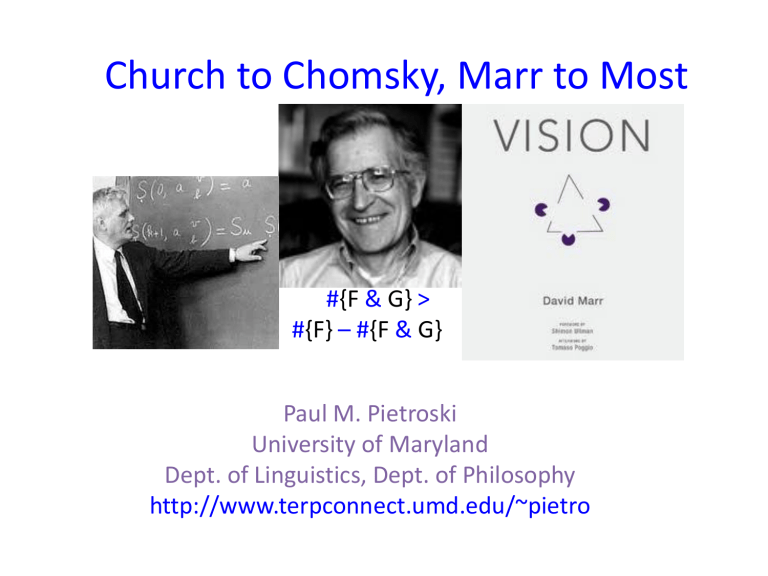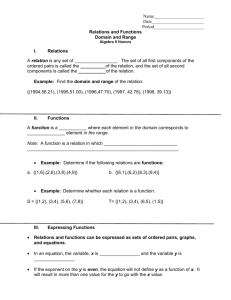ChurchToChomsky - TerpConnect

Church to Chomsky, Marr to Most
# {F & G} >
# {F} – # {F & G}
Paul M. Pietroski
University of Maryland
Dept. of Linguistics, Dept. of Philosophy http://www.terpconnect.umd.edu/~pietro
15 dots:
9 yellow
6 blue
Most of the dots are yellow
‘Most of the dots are yellow’
# {DOT & YELLOW} > # {DOT} /2
More than half of the dots are yellow
9 > 15/2
# {DOT & YELLOW} > # {DOT &
YELLOW}
The yellow dots outnumber the non yellow dots
There are more yellow dots than non yellow dots
s:s
{DOT & YELLOW}[ OneToOne [ s , {DOT &
YELLOW}]
9 > 6
# {DOT & YELLOW} > # {DOT} – # {DOT & YELLOW} 9 > (15 – 9)
The number of yellow dots exceeds the number of dots minus the number of yellow dots true in the same possible worlds… provably equivalent given arithmetic
Semantics: Mathematics or Psychology?
• One Relatively Safe Answer: Yes
(cp. “Animal Psychology: Statistics or Biology”)
• Further questions about “Subject Matter” are hard
(cp. celestial mechanics)
• But we’re talking about languages, and in particular, the “human languages” that kids can naturally acquire:
Human languages are “things” that pair meanings of some kind with sounds/gestures of some kind.
But “things” of what sort?
(And how are the meanings individuated?)
Many Conceptions of Human Languages
• complexes of “dispositions to verbal behavior”
• strings of an elicited (or nonelicited) corpus
• something a radical interpreter ascribes to a speaker
• “Something which assigns meanings to certain strings of types of sounds or marks. It could therefore be a function, a set of ordered pairs of strings and meanings.”
• a procedure that pairs meanings with sounds/gestures
I Before E: Church (1941, pp. 1-3) on Lambdas
• a function is a “rule of correspondence”
• underdetermines when “two functions shall be considered the same” function in intension computational procedure function in extension set of input-output pairs
|x – 1| + √(x 2 – 2x + 1)
{…(-2, 3), (-1, 2), (0, 1), (1, 0), (2, 1), …}
λx . |x – 1| = λx . + √(x 2 – 2x + 1)
λx . |x – 1| ≠ λx . + √(x 2 – 2x + 1)
Extension [ λx . |x – 1| ] = Extension [ λx . + √(x 2 – 2x + 1) ]
I Before E: Church (1941, pp. 1-3) on Lambdas
• a function is a “rule of correspondence”
• underdetermines when “two functions shall be considered the same” function in intension computational procedure function in extension set of input-output pairs
λD . λY . #{D & Y} > #{D}/2
λD . λY . #{D & Y} > #{D &
Y}
λD . λY . #{D & Y} > #{D} – #{D & Y}
…
Extension [ λD . λY . #{D & Y} > #{D &
Y} ] =
Extension [ λD . λY . #{D & Y} > #{D} – #{D & Y} ]
(cp. Frege on Functions vs. Courses-of-Values,
Marr on the function computed vs. the algorithm implemented)
I Before E: Church (1941, pp. 1-3) on Lambdas
In the calculus of L-conversion and the calculus of restricted
λ-K-conversion, as developed below, it is possible, if desired, to interpret the expressions of the calculus as denoting functions in extension.
However, in the calculus of λ-δ-conversion, where the notion of identity of functions is introduced into the system by the symbol δ, it is necessary, in order to preserve the finitary character of the
transformation rules, so to formulate these rules that an
interpretation by functions in extension becomes impossible.
The expressions which appear in the calculus of λ-δ-conversion are interpretable as denoting functions in intension of an appropriate kind.
”
I Before E Chomsky (1986, ch. 1) on Languages
i-language (intensional, internal, individual, implementable) : a procedure that connects
“meanings” with “articulations” in a particular way
e-language (extensional, external): a set of articulation-meaning pairs, or any another nonprocedural notion of language
I
Before E (especially after C)
• each human language L has unboundedly many expressions
• theorists want to specify these languages (without resorting to ‘…’)
• an ordinary human can understand the expressions of L, and understand them systematically, as if each speaker of L instantiates a corresponding generative procedure
• constrained homophony: many sound-meaning pairs are not expressions of L
The duck is ready to eat.
The duck is eager to eat.
The duck is easy to eat.
(
(duck as eater, duck as eaten)
(duck as eater,
#duck as eater
#duck as eaten
, duck as eaten)
)
Lewis, “Languages and Language”: E Before
I
“What is a language? Something which assigns meanings to certain
strings of types of sounds or marks. It could therefore be a function, a set of ordered pairs of strings and meanings.”
|x – 1| + √(x 2 – 2x + 1) {…(-2, 3), (-1, 2), (0, 1), (1, 0), (2, 1), …}
λx . |x – 1| = λx . + √(x 2 – 2x + 1)
“What is language? A social phenomenon which is part of the natural history of human beings; a sphere of human action ...”
“We may define a class of objects called grammars...
A grammar uniquely determines the language it generates. But a language does not uniquely determine the grammar that generates it.”
Lewis:
E
Before
I
I know of no promising way to make objective sense of the assertion that a grammar Γ is used by a population P, whereas another grammar Γ’ , which generates the same language as Γ , is not. I have tried to say how there are facts about P which objectively select the languages used by P.
I am not sure there are facts about P which objectively select privileged grammars for those languages ...a convention of truthfulness and trust in Γ will also be a convention of truthfulness and trust in Γ’ whenever Γ and Γ’ generate the same language .
I think it makes sense to say that languages might be used by populations even if there were no internally represented grammars . I can tentatively agree that £ is used by P if and only if everyone in P possesses an internal representation of a grammar for £ , if that is offered as a scientific hypothesis.
But I cannot accept it as any sort of analysis of “ £ i s used by P”, since
the analysandum clearly could be true although the analysans was false.
(Partee) Semantics: Mathematics or Psychology?
(Dummett) Semantics: Truth or Understanding?
• T-semantics: Tarski-style T-sentences as theorems leave it open how a semantic theory for a human language H is related to the phenomena of understanding (or acquiring) H; don’t assume that a theory of H is theory of an i-language
• U-semantics: a theory of understanding leave it open how the theory is related to the natural phenomena of using expressions to make truth-evaluable claims; but assume that a theory of a human language is theory of an i-language
Maybe for each human language L, some good T-semantics for L will turn out to be a good U-semantics for L
Lewis, "General Semantics”
“we can know the Markerese translation of an English sentence without knowing the first thing about the meaning of the English sentence; namely, the conditions under which it would be true.
Semantics with no truth conditions is no semantics.”
Really? Is the first thing about the meaning of
‘The sky is blue’ or ‘John is eager to please’ the conditions under which the sentence would be true? we can know the (alleged) conditions under which a sentence of a spoken language L would be true without knowing how (i.e., via what procedure) the sentence-sound is understood by any speakers of L.
Semantics without understanding is no semantics.
We can stipulate that a semantics just is a T-semantics. But then the question is whether a human language has a semantics, as
opposed to a U-semantics (cp. Harman, “Meaning and Semantics”)
15 dots:
9 yellow
6 blue
Most of the dots are yellow
‘Most of the dots are yellow’
MOST [DOT(x), YELLOW(x)]
# {x:DOT(x) & YELLOW(x)} > # {x:DOT(x)} /2
More than half of the dots are yellow (9 > 15/2)
# {x:DOT(x) & YELLOW(x)} > # {x:DOT(x) &
YELLOW(x)}
The yellow dots outnumber the non yellow dots (9 > 6)
# {x:DOT(x) & YELLOW(x)} > # {x:DOT(x)} – # {x:DOT(x) & YELLOW(x)}
The number of yellow dots exceeds the number of dots minus the number of yellow dots
(9 > 15 – 9)
Hume’s Principle
# {x:T(x)} = # {x:H(x)} iff
{x:T(x)} OneToOne {x:H(x)}
____________________________________________
# {x:T(x)} > # {x:H(x)} iff
{x:T(x)} OneToOnePlus {x:H(x)}
α OneToOnePlus β iff for some α*,
α* is a proper subset of α, and α* OneToOne β
(and it’s not the case that β OneToOne α)
‘Most of the dots are yellow’
MOST [DOT(x), YELLOW(x)]
# {x:DOT(x) & YELLOW(x)} > # {x:DOT(x)} /2
# {x:DOT(x) & YELLOW(x)} > # {x:DOT(x) &
YELLOW(x)}
# {x:DOT(x) & YELLOW(x)} > # {x:DOT(x)} – # {x:DOT(x) & YELLOW(x)}
OneToOnePlus [{x:DOT(x) & YELLOW(x)}, {x:DOT(x) &
YELLOW(x)}]
‘Most of the dots are yellow’
MOST [D, Y]
OneToOnePlus [{D & Y},{D &
Y}]
# {D & Y} > # {D &
Y}
# {D & Y} > # {D} /2
# {D & Y} > # {D} – # {D & Y}
???Most of the paint is yellow???
Tim
Hunter
Darko
Odic
Justin Halberda
L i d z
J f f e
A W l e e l x l i w s o o d
Most of the dots are yellow
‘Most of the dots are yellow’
MOST [D, Y]
OneToOnePlus [{D & Y},{D &
Y}]
# {D & Y} > # {D &
Y}
# {D & Y} > # {D} /2
# {D & Y} > # {D} – # {D & Y}
Some Relevant Facts
• many animals are good cardinality-estimaters, by dint of a much studied system (see Dehaene, Gallistel/Gelman, etc.)
• appeal to subtraction operations is not crazy (Gallistel/King)
• but...infants can do one-to-one comparison (see Wynn)
• and Frege’s versions of the axioms for arithmetic can be derived (within a consistent fragment of Frege’s logic) from definitions and Hume’s (one-to-one correspondence) Principle
• Lots of references in…
The Meaning of 'Most’. Mind and Language (2009).
Interface Transparency and the Psychosemantics of ‘most’.
Natural Language Semantics (2011).
‘Most of the dots are yellow’
MOST [D, Y]
OneToOnePlus [{D & Y},{D &
Y}]
# {D & Y} > # {D &
Y}
# {D & Y} > # {D} – # {D & Y}
Are most of the dots yellow?
What conditions make the question easy/hard to answer?
That might provide clues about how we understand the question
(given decent accounts of what information is available to us in those conditions).
a model of the “Approximate Number System”
(key feature: ratio-dependence of discriminability) distinguishing 8 dots from 4 (or 16 from 8) is easier than distinguishing 10 dots from 8 (or 20 from 10)
a model of the “Approximate Number System”
(key feature: ratio-dependence of discriminability) correlatively, as the number of dots rises,
“acuity” for estimating of cardinality
decreases--but still in a ratio-dependent way, with wider “normal spreads” centered on right answers
4:5 (blue:yellow)
“scattered pairs”
1:2 (blue:yellow)
“scattered pairs”
4:5 (blue:yellow)
“scattered pairs”
9:10 (blue:yellow)
“scattered pairs”
4:5 (blue:yellow)
“column pairs sorted”
4:5 (blue:yellow)
“column pairs mixed”
5:4 (blue:yellow)
“column pairs mixed”
scattered random
4:5 (blue:yellow) scattered pairs column pairs mixed column pairs sorted
Basic Design
• 12 naive adults, 360 trials for each participant
• 5-17 dots of each color on each trial
• trials varied by ratio (from 1:2 to 9:10) and type
• each “dot scene” displayed for 200ms
• target sentence: Are most of the dots yellow?
• answer ‘yes’ or ‘no’ by pressing buttons on a keyboard
• correct answer randomized
• controls for area (pixels) vs. number, yada yada…
100
90
80
70
60
50
1
10 : 10 better performance on easier ratios: p < .001
Scattered Random
Scattered Pairs
Column Pairs Mixed
Column Pairs Sorted
1.5
Ratio (Weber Ratio)
10 : 15
2
10 : 20
fits for Sorted-Columns trials to an independent model for detecting the longer of two line segments fits for trials
(apart from Sorted-Columns) to a standard psychophysical model for predicting ANS-driven performance
performance on Scattered Pairs and Mixed Columns was no better than on Scattered Random; looks like ANS was used to answer the question, except in the Sorted Columns trials
scattered random
4:5 (blue:yellow) scattered pairs column pairs mixed column pairs sorted
Follow-Up Study
Could it be that speakers use ‘most’ to access a 1-To-1-Plus concept , but our task made it too hard to use a 1-To-1-Plus verification strategy ?
4:5 (blue:yellow)
“scattered pairs”
What color are the loners?
better performance on components of a 1-to-1-plus task
10 : 10
10 : 15
10 : 20
We are NOT saying...
• that speakers always/usually verify sentences of the form
‘Most of the Ds are Ys’ by computing
# {D & Y} > # {D} – # {D & Y}
• that if there are some tasks in which speakers do not verify
‘Most of the Ds are Ys’ by using a one-to-one correspondence strategy,
then ‘Most’ is not understood in terms of a one-to-one correspondence
But we are (tentatively) assuming that...
if speakers understand sentences of the form
‘Most of the Ds are Ys’ as claims of the form
# {D & Y} > # {D} – # {D & Y} then other things equal, speakers will use this “logical form” as a verification strategy
if they can easily do so
Compare:
‘Bert arrived and Ernie left’
fits for Sorted-Columns trials to an independent model for detecting the longer of two line segments fits for trials
(apart from Sorted-Columns) to a standard psychophysical model for predicting ANS-driven performance
performance on Scattered Pairs and Mixed Columns was no better than on Scattered Random; looks like ANS was used to answer the question, except in the Sorted Columns trials
Side Point…50% plus a tad
‘Most of the dots are yellow’
MOST [D, Y]
OneToOnePlus [{D & Y},{D &
Y}]
# {D & Y} > # {D &
Y}
# {D & Y} > # {D} – # {D & Y}
‘Most of the dots are blue’
#{x:Dot(x) & Blue(x)} > #{x:Dot(x) & ~Blue(x)}
#{x:Dot(x) & Blue(x)} > #{x:Dot(x)} − #{x:Dot(x) & Blue(x)}
• if there are only two colors to worry about, say blue and red, then the non-blues can be identified with the reds
‘Most of the dots are blue’
#{x:Dot(x) & Blue(x)} > #{x:Dot(x) & ~Blue(x)}
#{x:Dot(x) & Blue(x)} > #{x:Dot(x)} − #{x:Dot(x) & Blue(x)} if there are only two colors to worry about, say blue and red, then the non-blues can be identified with the reds
• the visual system can (and will) “select” the dots, the blue dots, and the red dots; so the ANS can estimate these three cardinalities but adding more colors will make it harder (and with 5 colors,
impossible) for the visual system to make enough “selections” for the ANS to operate on
‘Most’ as a Case Study
‘Most of the dots are blue’
#{x:Dot(x) & Blue(x)} > #{x:Dot(x) & ~Blue(x)}
#{x:Dot(x) & Blue(x)} > #{x:Dot(x)} − #{x:Dot(x) & Blue(x)}
• adding alternative colors will make it harder (and eventually impossible) for the visual system to make enough “selections” for the ANS to operate on
• so given the first proposal (with negation), verification should get harder as the number of colors increases
• but the second proposal (with subtraction) predicts relative indifference to the number of alternative colors
better performance on easier ratios: p < .001
no effect of number of colors
fit to psychophysical model of
ANS-driven performance
‘Most’ as a Case Study
‘Most of the dots are blue’
#{x:Dot(x) & Blue(x)} > #{x:Dot(x) & ~Blue(x)}
#{x:Dot(x) & Blue(x)} > #{x:Dot(x)} − #{x:Dot(x) & Blue(x)}
• adding alternative colors will make it harder (and eventually impossible) for the visual system to make enough “selections” for the ANS to operate on
• so given the first proposal (with negation), verification should get harder as the number of colors increases
• but the second proposal (with subtraction) predicts relative indifference to the number of alternative colors
‘Most of the dots are yellow’
MOST [D, Y]
OneToOnePlus [{D & Y},{D &
Y}]
# {D & Y} > # {D &
Y}
# {D & Y} > # {D} /2
# {D & Y} > # {D} – # {D & Y}
???Most of the paint is yellow???
‘Most’ as a Case Study
‘Most of the dots are blue’
#{x:Dot(x) & Blue(x)} > #{x:Dot(x)} − #{x:Dot(x) & Blue(x)}
• mass/count flexibility
Most of the dots (blobs) are brown
Most of the goo (blob) is brown
• are mass nouns (somehow) disguised count nouns?
#{x:GooUnits(x) & BlueUnits(x)} >
#{x:GooUnits(x)} − #{x:GooUnits(x) & BlueUnits(x)}
discriminability is BETTER for ‘goo’ (than for ‘dots’) w = .18
r 2 = .97
w = .27
r 2 = .97
Are more of the blobs blue or yellow?
If more the blobs are blue, press ‘F’. If more of the blobs are yellow, press ‘J’.
Is more of the blob blue or yellow?
If more the blob is blue, press ‘F’. If more of the blob is yellow, press ‘J’.
100
95
90
85
80
75
70
65
60
55
50
1.0
Performance is better (on the same stimuli) when the question is posed with a mass noun
1.2
1.4
1.6
1.8
Ratio (Bigger Quantity/ Smaller Quantity)
2.0
2.2
r r w = .20
2 = .99
w = .29
2
Mass Data
Mass Model
Count Data
Count Model
= .98
‘Most’ as a Case Study
‘Most of the dots are blue’
#{x:Dot(x) & Blue(x)} > #{x:Dot(x)} − #{x:Dot(x) & Blue(x)}
• mass/count flexibility
Most of the dots (blobs) are brown
Most of the goo (blob) is brown
• are mass nouns disguised count nouns?
SEEMS NOT
#{x:GooUnits(x) & BlueUnits(x)} >
#{x:GooUnits(x)} − #{x:GooUnits(x) & BlueUnits(x)}
Procedure Matters
...Psychophysics, on the other hand, is related more directly to the level of algorithm and representation.
Different algorithms tend to fail in radically different ways as they are pushed to the limits of their performance or are deprived of critical information.
As we shall see, primarily psychophysical evidence proved to Poggio and myself that our
first stereo-matching algorithm was not the one used by the brain, and the best evidence that our second algorithm
(Marr and Poggio, 1976) is roughly the one used also comes from psychophysics.
Of course, the underlying computational theory remained the same in both cases, only the algorithms were different.
Psychophysics can also help to determine the nature of a representation...
Procedure Matters
MOST [D, Y]
OneToOnePlus [{D & Y},{D &
Y}]
# {D & Y} > # {D &
Y}
# {D & Y} > # {D} /2
# {D & Y} > # {D} – # {D & Y}
THANKS
E
Before
I
in Vision
I know of no promising way to make objective sense of the assertion that a computational procedure Γ is used by a population P, whereas another procedure Γ’ , which generates the same set of retinal-image/3D-sketch pairs as Γ , is not. I have tried to say how there are facts about P which objectively
select the Vision-Sets used by P. I am not sure there are facts about P which
objectively select privileged computational procedures for those Vision-Sets ...
I think it makes sense to say that Vision-Sets might be used by populations even if there were no internally represented procedures . I can tentatively agree that V is used by P if and only if everyone in P possesses an internal representation of a procedure for V , if that is offered as a scientific hypothesis. But I cannot accept it as any sort of analysis of “ V i s used by P”, since the analysandum clearly could be true although the analysans was
false.
A Possible Line of Thought
Truth Conditional Semantics
Lewisian metasemantics rooted in conventions of truth/trustfulness
The object languages are Lewisian functions (sets of a certain sort), as opposed to Chomskian i-languages (procedures of a certain sort)





